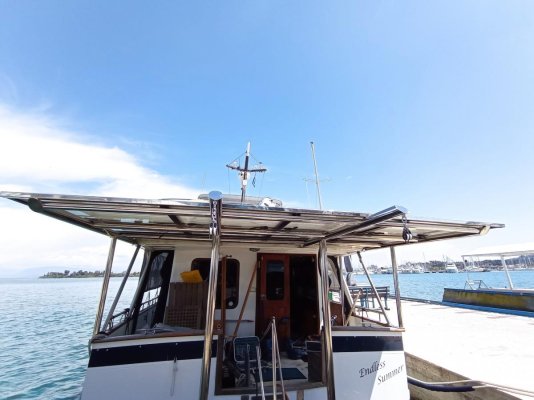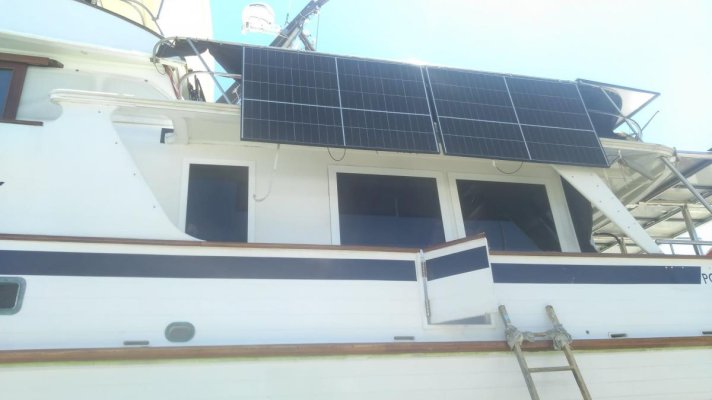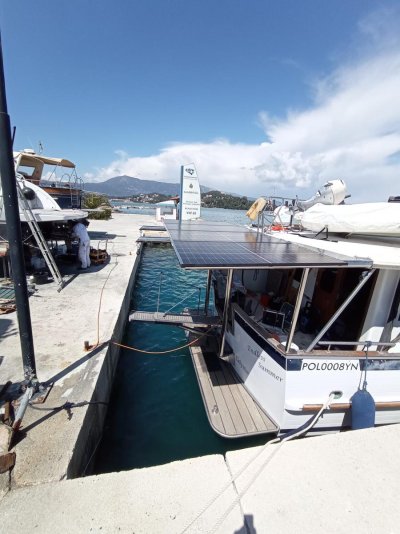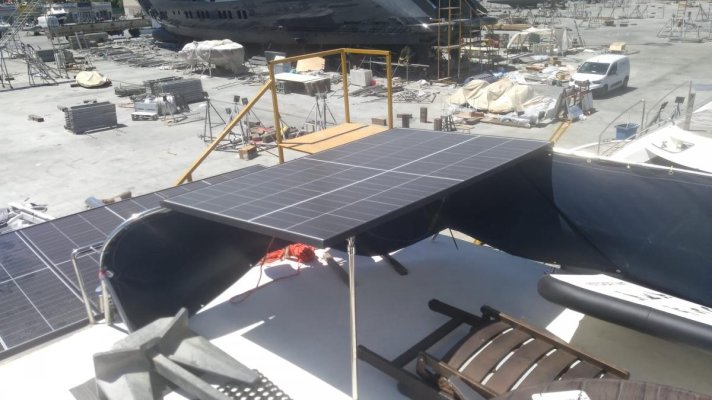danderer
Guru
Looking for ideas about adding charge capacity.
Existing setup is 1000Ah of AGM as house bank, a Multiplus 3Kw, Cerbo GX, and BVM-702. The engine has a 320A alternator and WS500 regulator.
Usage is about 400 Ah/day.
The current setup works fine most of the time. If going to a dock to plug in the then Mutltiplus handles the charging load fine. If underway the 320A alternator (putting 200A into the house bank) is very satisfactory.
The unsatisfactory case is sitting at anchor for several days, requiring the generator to run 4 hours a day for the Multiplus to replenish the house bank. I'd like to reduce that run time. I've had several thoughts:
1. Get an additional 100A batter charger, on a separate breaker, that I can use in in addition to the Multiplus to charge the batteries. It would only be used in the case where charging is from the generator.
2. Get an additional Multiplus and parallel it with the existing. While that sounds attractive I see problems: I don't have the space to co-locate it with the existing unit so the cable runs will be significantly different, the cable requirements are honking big, I'd have to upgrade AC cabling and breakers, and I've read of problems getting parallel units to function correctly if they are from different production runs and/or firmware. I also don't need the additional inverting capacity.
3. Get an additional Multiplus and set it to charge-only mode. Do NOT parallel it with the existing unit. It would be on a separate breaker, used as an additional charge source only. It would not need to be co-located with the existing Multiplus and the cabling requirements would be easier to manage. Importantly it would be available as a spare should the primary unit fail - just swap out the primary and swap in the secondary. (The inverter is a critical system for us and currently there is no backup other than running the generator.) The price difference between a 2nd Multiplus and a quality 100A charger seems pretty small.
I'm leaning towards #3 at the moment. Thoughts? Problems I've overlooked?
Oh, as to some obvious answers:
- No good space for a solar installation to make a meaningful difference.
- I don't see lithium as a magic bullet. My limitation isn't charge-acceptance, it is charge-generation. When using the generator I don't drive the batteries to float, just into the acceptance range.
Existing setup is 1000Ah of AGM as house bank, a Multiplus 3Kw, Cerbo GX, and BVM-702. The engine has a 320A alternator and WS500 regulator.
Usage is about 400 Ah/day.
The current setup works fine most of the time. If going to a dock to plug in the then Mutltiplus handles the charging load fine. If underway the 320A alternator (putting 200A into the house bank) is very satisfactory.
The unsatisfactory case is sitting at anchor for several days, requiring the generator to run 4 hours a day for the Multiplus to replenish the house bank. I'd like to reduce that run time. I've had several thoughts:
1. Get an additional 100A batter charger, on a separate breaker, that I can use in in addition to the Multiplus to charge the batteries. It would only be used in the case where charging is from the generator.
2. Get an additional Multiplus and parallel it with the existing. While that sounds attractive I see problems: I don't have the space to co-locate it with the existing unit so the cable runs will be significantly different, the cable requirements are honking big, I'd have to upgrade AC cabling and breakers, and I've read of problems getting parallel units to function correctly if they are from different production runs and/or firmware. I also don't need the additional inverting capacity.
3. Get an additional Multiplus and set it to charge-only mode. Do NOT parallel it with the existing unit. It would be on a separate breaker, used as an additional charge source only. It would not need to be co-located with the existing Multiplus and the cabling requirements would be easier to manage. Importantly it would be available as a spare should the primary unit fail - just swap out the primary and swap in the secondary. (The inverter is a critical system for us and currently there is no backup other than running the generator.) The price difference between a 2nd Multiplus and a quality 100A charger seems pretty small.
I'm leaning towards #3 at the moment. Thoughts? Problems I've overlooked?
Oh, as to some obvious answers:
- No good space for a solar installation to make a meaningful difference.
- I don't see lithium as a magic bullet. My limitation isn't charge-acceptance, it is charge-generation. When using the generator I don't drive the batteries to float, just into the acceptance range.




